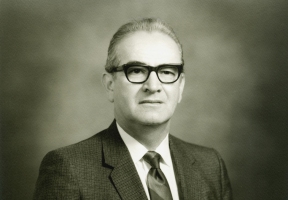By Daniel Nardini
 Running almost parallel to the civil rights movement in the southeastern part of the United States by Dr. Martin Luther King, Jr., was a similar civil rights movement for the rights of Mexican Americans in the U.S. southwest by Dr. Hector Garcia. Dr. Garcia and his organization the American G.I. Forum fought important legal battles that desegregated the legal discrimination against Mexican Americans. Just as African Americans celebrate the legacy of Dr. King, so too should Mexican Americans and Latinos celebrate the legacy of Dr. Garcia. Dr. Hector Garcia was born on January 17, 1914, in the town of Llera, Mexico. His parents were school teachers. When the Mexican Revolution (1910 to 1920) broke out, his family fled to Texas to escape the carnage. Even though his parents were well educated, the Texan authorities did not accept their credentials due to the barrio laws—legal discriminatory ordinances that prohibited Mexican Americans from living in certain communities (white communities), being employed in certain professions, attending schools in white neighborhoods, and even being buried in white cemeteries. It is these laws that Dr. Garcia would eventually fight against.
Running almost parallel to the civil rights movement in the southeastern part of the United States by Dr. Martin Luther King, Jr., was a similar civil rights movement for the rights of Mexican Americans in the U.S. southwest by Dr. Hector Garcia. Dr. Garcia and his organization the American G.I. Forum fought important legal battles that desegregated the legal discrimination against Mexican Americans. Just as African Americans celebrate the legacy of Dr. King, so too should Mexican Americans and Latinos celebrate the legacy of Dr. Garcia. Dr. Hector Garcia was born on January 17, 1914, in the town of Llera, Mexico. His parents were school teachers. When the Mexican Revolution (1910 to 1920) broke out, his family fled to Texas to escape the carnage. Even though his parents were well educated, the Texan authorities did not accept their credentials due to the barrio laws—legal discriminatory ordinances that prohibited Mexican Americans from living in certain communities (white communities), being employed in certain professions, attending schools in white neighborhoods, and even being buried in white cemeteries. It is these laws that Dr. Garcia would eventually fight against.
Despite all of the discrimination he endured for his choice of going to college, Dr. Garcia was accepted and attended the University of Texas in Austin. He graduated from there with a degree in zoology, and studied medicine at the University of Texas Medical Branch where he received his doctorate in medicine. From there he interned at St. Joseph’s Hospital at Creighton University in Omaha, Nebraska. In 1942, he was called up to serve in the medical corps of the U.S. Army during World War II. He served in the Italian Campaign. It was in Italy he met his future wife Wanda Fusillo. They married and when the war ended in 1945, Dr. Garcia and Wanda returned to live in Corpus Christi, Texas. During the war, Dr. Garcia had earned the Bronze Star Medal, the European African Middle Eastern Medal, and the World War II Victory Medal. Upon returning home, Dr. Garcia had become a World War II hero.
However, discrimination was still an issue. Dr. Garcia fought for other Latino American veterans who were either not receiving their benefits promptly, or were being denied their benefits. To fight for the rights of Latino American veterans, Dr. Garcia formed the American G.I. Forum—an organization dedicated to fight not only for veterans but also for the rights of Mexican Americans. This fight soon became a crusade by Dr. Garcia for the basic dignities of all Latino American veterans. In 1949, the body of a fallen Latino American soldier named Felix Z. Longoria, Jr., was returned to the United States for burial. When Longoria’s widow wanted her fallen husband buried in a military funeral at the Three Rivers chapel, the funeral director refused to allow this because Longoria was not white. Dr. Garcia and the American G.I. Forum took up the cause, and through the intervention of then U.S. Senator Lyndon B. Johnson, were able to secure a military burial with full honors at Arlington National Cemetery for Longoria.
This fight for Longora was the opening salvo by Dr. Garcia and the American G.I. Forum to get rid of all the barrio laws that legally discriminated against Latinos. When the U.S. Supreme Court ruled in the case Brown vs. the Board of Education that overturned segregation, Dr. Garcia and the American G.I. Forum fought to enforce desegregation in the schools not only in Texas but also in Arizona and Colorado. Dr. Garcia and the American G.I. Forum campaigned heavily for then Democratic presidential candidate John F. Kennedy who wanted to end segregation in the U.S. South and the U.S. Southwest, and when Kennedy won, the new Kennedy administration worked hard to roll back the barrio laws. Among the successes credited to Dr. Garcia and the American G.I. Forum was the repeal of the Texas poll tax that had prevented poor Latinos from voting, and the laws that prohibited Mexican Americans from living in white neighborhoods and being buried in white cemeteries. For his work, Dr. Garcia received the U.S. Presidential Medal of Freedom in 1980, and his last crusade was trying to help the towns and villages mostly populated by Mexican Americans along the U.S.-Mexico border. He died on July 26, 1996, at the age of 82.
 Villanueva-Backed Law to Protect Access to Illinois Courthouses December 11, 2025
Villanueva-Backed Law to Protect Access to Illinois Courthouses December 11, 2025








Dr. Hector Garcia: Mexican American Civil Rights Activist
By Daniel Nardini
Despite all of the discrimination he endured for his choice of going to college, Dr. Garcia was accepted and attended the University of Texas in Austin. He graduated from there with a degree in zoology, and studied medicine at the University of Texas Medical Branch where he received his doctorate in medicine. From there he interned at St. Joseph’s Hospital at Creighton University in Omaha, Nebraska. In 1942, he was called up to serve in the medical corps of the U.S. Army during World War II. He served in the Italian Campaign. It was in Italy he met his future wife Wanda Fusillo. They married and when the war ended in 1945, Dr. Garcia and Wanda returned to live in Corpus Christi, Texas. During the war, Dr. Garcia had earned the Bronze Star Medal, the European African Middle Eastern Medal, and the World War II Victory Medal. Upon returning home, Dr. Garcia had become a World War II hero.
However, discrimination was still an issue. Dr. Garcia fought for other Latino American veterans who were either not receiving their benefits promptly, or were being denied their benefits. To fight for the rights of Latino American veterans, Dr. Garcia formed the American G.I. Forum—an organization dedicated to fight not only for veterans but also for the rights of Mexican Americans. This fight soon became a crusade by Dr. Garcia for the basic dignities of all Latino American veterans. In 1949, the body of a fallen Latino American soldier named Felix Z. Longoria, Jr., was returned to the United States for burial. When Longoria’s widow wanted her fallen husband buried in a military funeral at the Three Rivers chapel, the funeral director refused to allow this because Longoria was not white. Dr. Garcia and the American G.I. Forum took up the cause, and through the intervention of then U.S. Senator Lyndon B. Johnson, were able to secure a military burial with full honors at Arlington National Cemetery for Longoria.
This fight for Longora was the opening salvo by Dr. Garcia and the American G.I. Forum to get rid of all the barrio laws that legally discriminated against Latinos. When the U.S. Supreme Court ruled in the case Brown vs. the Board of Education that overturned segregation, Dr. Garcia and the American G.I. Forum fought to enforce desegregation in the schools not only in Texas but also in Arizona and Colorado. Dr. Garcia and the American G.I. Forum campaigned heavily for then Democratic presidential candidate John F. Kennedy who wanted to end segregation in the U.S. South and the U.S. Southwest, and when Kennedy won, the new Kennedy administration worked hard to roll back the barrio laws. Among the successes credited to Dr. Garcia and the American G.I. Forum was the repeal of the Texas poll tax that had prevented poor Latinos from voting, and the laws that prohibited Mexican Americans from living in white neighborhoods and being buried in white cemeteries. For his work, Dr. Garcia received the U.S. Presidential Medal of Freedom in 1980, and his last crusade was trying to help the towns and villages mostly populated by Mexican Americans along the U.S.-Mexico border. He died on July 26, 1996, at the age of 82.